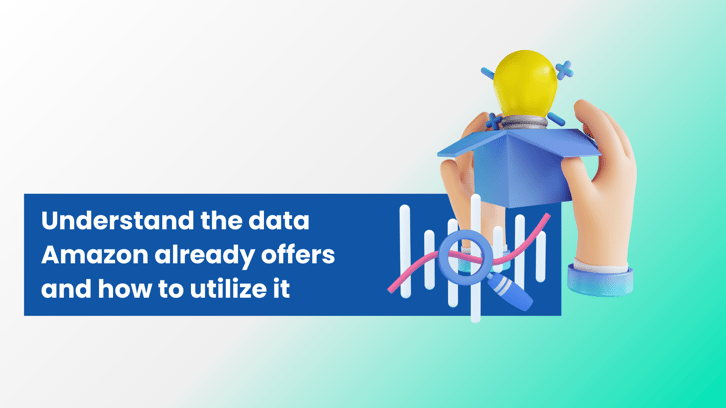Amazon Analytics Tools – 5 Steps to Finding the Right One for Your Business
As the demand for increased visibility rises, Amazon is providing Sellers with an expanding pool of data. This presents an opportunity for gaining valuable insights, motivating Sellers to enhance their ability to derive such insights through analytics tools - but how do you determine the best analytics tools for your business? In this blog, we will give you 5 actionable tips on how to select the best software for your business to utilize this data. Let’s get started!
Step 1: Discover your brand’s end goal
To narrow down your choice of analytics software, consider your overarching goals as a business. For example, to boost market share, prioritize selecting a tool that offers strong competitor analysis features. To elevate profitability, choose a tool that helps lower marketing expenses, execute successful upselling techniques, and provide comprehensive insights into Customer Lifetime Value (CLV). With a well-defined understanding of your goals, investigate tools designed for Amazon Sellers that match these objectives.
Improving Amazon analytics shouldn't be your ultimate aim; instead, focus on expanding your market share by XX or experiencing a boost in profitability. This process is crucial whether you’re new to Seller Central or already have a solid sales record and a well-established Amazon business.
Step 2: Understand the data Amazon already offers and how to utilize it

It is always best to begin with what you already have access to. Begin by delving into the rich data resources provided by Amazon, accessible through its complimentary tools for Sellers, including Amazon Advertising reports and Amazon Brand Analytics (ABA). These will help to establish a starting point for understanding and analyzing crucial data.
While the free Amazon reports might be adequate for small enterprises, handling a large volume of product listings can become an obstacle in converting data into actionable strategies. It remains advantageous to acquaint oneself with these free resources before exploring third-party alternatives, yet they present two major difficulties: an absence of concrete figures and a scarcity of contextual details. Even though certain improvements, such as the ABA Search Term Report, now offer insights into real search volumes instead of merely popular search terms, challenges remain. Sellers still need to sift through multiple reports to derive actionable insights.
For individuals in the initial phases or managing small-scale projects, leveraging Amazon's resources and incorporating data into spreadsheets presents an economical approach. Amazon conveniently provides all necessary information in CSV files, facilitating regular email delivery. It's important to understand that Amazon Brand Analytics (ABA) does not store data forever, underlining the need to export and preserve data for ongoing analysis. Although manually refining Amazon's basic data enables the monitoring of key long-term trends and the development of personas, expanding manual analysis can prove difficult as the volume of Amazon's data increases.
To streamline Excel automation, tools like Supermetrics, PowerBI, and Tableau can be beneficial. Although they provide excellent dashboards for exploratory analysis, these are third-party tools that necessitate investment. Should the manual management and analysis of Amazon data appear overwhelming, third-party analytics tools are worth considering. They centralize and streamline the data review process, offer insights for both long and short-term strategies, and improve the depth of analysis beyond what manual methods can achieve.
Step 3: Look to integrate your Amazon data
Pause to reflect on integration — Amazon's data offers invaluable perspectives on consumer habits and buying trends. However, this data is spread across various locations, posing a challenge for a complete and cohesive analysis. Some solutions excel in adapting to data trends and curating the most relevant reports.
Automation software must effortlessly retrieve data across the entire Amazon ecosystem, including advertising, retail, and beyond. For a detailed, transaction-level view of product performance instead of a general summary, utilizing the Amazon Selling Partners API (SP-API) is essential—a significant improvement over Amazon Marketplace Web Services. Moreover, a proficient tool should broaden its integration to include data from additional sales channels you might use.
Step 4: Prioritize transparency and data access

In-depth analytics provides the benefit of recognizing patterns and trends, facilitating the replication of successful strategies and reducing failures. With strong data and analytical resources, businesses can adopt proactive steps to remain competitive. By cutting down on time dedicated to data analysis, organizations can capitalize on data-driven insights for enhanced business results. Transparency and access to data are crucial, as knowing the origins of decisions helps in tracking the relationship between marketing initiatives and sales results. A thorough system that offers daily updates and detailed data access boosts confidence, enabling strategic decisions and internal changes based on the most profitable days, products, and campaigns.
A tool that elucidates the reasoning behind its decisions or recommendations, while offering access to the foundational data as needed, will enable smooth integrations throughout your entire operation. This, in turn, allows you to make crucial cross-departmental decisions and internal adjustments, informed by insights into the most profitable days, products, and campaigns.
Step 5: Stay focused on outcomes
The ideal analytics tool ought to assist you in making more informed decisions, offer significant insights, and elucidate the reasons behind specific occurrences within your business. It should also offer suggestions for improvement. The key outcomes you're aiming for with analytics include;
- creating detailed customer personas
- understanding buying patterns
- determining the value of each customer
- optimizing search terms and keywords for better results in your Amazon business
The tool is designed to display information in a user-friendly manner, enabling you to customize your strategies for optimal results.
By gathering data from throughout the Amazon ecosystem, it seeks to comprehend customer behavior and develop real-time, comprehensive customer profiles. The key challenge is to leverage pertinent information effectively, underscoring the importance of an analytics tool capable of effortlessly fulfilling this objective.
Moreover, analytics tools can extract 'buying trajectories' from consumer purchasing behaviors, leveraging Amazon's insights on purchase amounts and detailed data from Amazon SP-API. By correlating this information with customer profiles, precise forecasts are generated, facilitating tailored advertising and the development of product bundles.
Over time, these instruments are capable of analyzing data on recurring purchases, integrating this with persona and PPC information to calculate each customer's value and offer valuable insights for managing inventory. Powered by machine learning, analytics tools improve search term and keyword optimization by examining the performance of product categories. They provide a detailed understanding by merging persona categories, analyzing geo-locations, conducting product research, comparing baskets, and observing purchasing behaviors - all displayed on a user-friendly dashboard.
What the right tool for the job looks like

Selecting the appropriate analytics tool or platform represents a strategic commitment, necessitating investment of time, effort, and financial resources. The key is to select a tool that not only meets your current business needs but also facilitates growth and scalability. Given the dynamic nature of the Amazon ecosystem, adaptability is paramount. Your chosen approach should recognize the ongoing changes and be able to adeptly incorporate emerging data types.
Consider consulting services to enhance your analytics journey. Data specialization experts can offer crucial insights into tailoring software tools to meet your precise requirements. Although many SaaS products come with self-service capabilities, consulting services guarantee proper alignment with your strategic goals. Also, analytics can reveal business challenges these expert services can address effectively.
When evaluating analytics setups, the central question is how they contribute to your success amidst intensifying marketplace competition. The true efficacy of any analytics tool lies in its ability to enhance and guide your actions. Ultimately, the goal is not just to gather clever insights but to actively utilize them for thriving in the Amazon market. Prioritize analytics tools that deliver faster and more actionable results to maximize your impact in this ever-evolving landscape.
About Nozzle:
Nozzle transforms raw data into actionable insights, empowering Amazon sellers to enhance their business growth while reclaiming control of vital customer data. Historically frustrated by limited access to customer information, sellers can now leverage Nozzle Analytics to track sales in real time and gain valuable insights into customer purchasing behaviors.
In the highly competitive Amazon marketplace, where increasing Cost Per Click (CPC) and a growing number of sellers present challenges, accessing customer data is essential for optimizing Pay-Per-Click (PPC) advertisements, ensuring cost-effectiveness, and accurately targeting keywords.
Nozzle's real-time data capabilities offer a deep understanding of essential metrics such as Return on Ad Spend (RoAS) and break-even ACoS using Life-Time Value (LTV) and Customer Acquistion Costs (CAC), enabling strategic decision-making to stay ahead of the competition.

